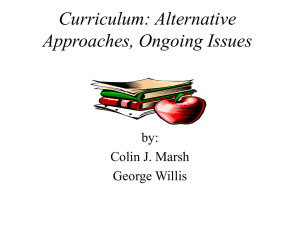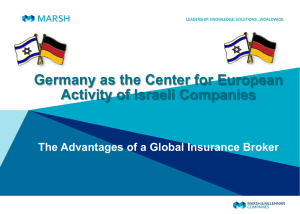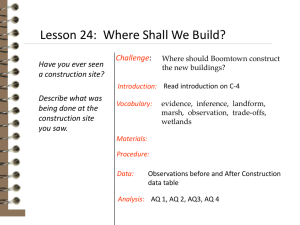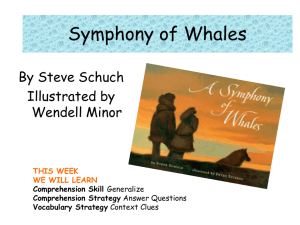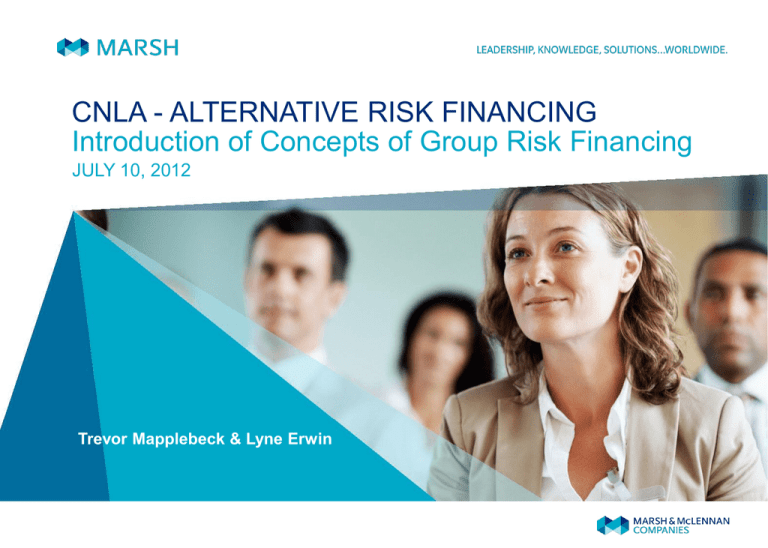
CNLA - ALTERNATIVE RISK FINANCING
Introduction of Concepts of Group Risk Financing
JULY 10, 2012
Trevor Mapplebeck & Lyne Erwin
Agenda
• Background of CNLA HortProtect Program & Marsh
– Program participation and performance
– Risk Profile
• Group Funded Deductible
– Goals of risk sharing
– Structure
– How claims are paid
– Risk Management Benefits
• Next Steps
• Success Story from CURIE (Canadian University Reciprocal)
– Presented by Keith Shakespeare
MARSH
29 April 2015
1
Background
• CNLA tendered the insurance broker services in summer of 2010
• Marsh appointed September 15, 2010
• Newly sponsored program exclusive to members launched October 15,
2010 with RSA
– Member of CNLA and in good standing
– Duly completed application in order to obtain quotation
– Overview of current best practices including contracts
– Claims details
– Snow removal up to 40% of overall revenue
MARSH
29 April 2015
2
Program Overview
• 101 members participating in the program for a total written premium of $1,382,301
• Membership breakdown
– 91 members less than $25,000 in annual premium (small)
– 5 members between $25,001 and $50,000 in annual premium (medium)
– 5 members over $50,001 in annual premium (large)
• Breakdown by line of business
- Property $ 615,047
- Liability $ 173,119
- Automobile $594,135
• Incurred losses by line of business
– 5 slip & falls $38,180 = 22% loss ratio
– 5 property (theft, water damage, windstorm damage) $49,479 = 8% loss ratio
– 11 auto (collision and third party liability) $160,083 = 29% loss ratio
• Total incurred losses $247,743 for an overall loss ratio of 18%
MARSH
29 April 2015
3
Why Share Risk?
• Recognition of superior risk profile
• Long term control
• Better insulation from cyclical marketplace/hardening market
• Premium savings of higher retentions used to finance group fund
(Member’s losses determine premium within the fund)
• Efficient/high-quality service from independent service providers
• Return of profits/investment income potential
• Cost of excess liability reduced with volume purchase
• Quality membership selection – minimum risk management standard to
gain entry
MARSH
29 April 2015
4
Goals for Risk Sharing
• Develop critical mass to generate economies of scale
• Ensure ongoing best practices in terms of safety, compliance and risk
management
– Accountability within the risk sharing pool
• Develop a loss pool
– Capitalize for expected and unexpected losses
– Centralize loss control and claims data to evaluate loss pool –
anonymous when shared
– Create risk management education/awareness programs
– Develop capital base to evaluate more formalized alternative risk
financing programs (captive, reciprocal, mutual)
– Dividends back to members based on their pro rata share of profits from
positive results of group fund
MARSH
29 April 2015
5
Key Considerations
For Members participating in a Group Funded program
•
Long term commitment
•
Management of claims
•
Governance/oversight of the Fund
– Committee or full participation
•
Set up costs – analysis and
implementation
•
Operating costs
•
Insurance premium related costs
•
Risk of adverse underwriting results
•
Capitalization requirements
•
Potential Letter of Credit requirements
For Members not participating in a Group Funded program
• Risk transfer program excess of Group Fund will be marketed with the main program
for Members not participating in the Group Fund
• This will ensure benefit of the group insurance program for Members choosing
not to participate is not lost on the creation of the Group Fund
• Fund can remain open to Members who see future value in the Group Fund
MARSH
29 April 2015
6
Group funded deductible – first stage of risk sharing
• Each member carries a “working layer” deductible
• Losses above deductible are paid out of a risk pool that is shared by all
members
– Premiums are based on risk and exposure
– All members pay for losses of one another
– Avoid trading dollars with insurers for predictable losses
– Control over management of claims within the Group deductible
– Investment income potential on funds not required for claims
• Group fund financial risk is capped
• Excess insurance needs are marketed as a group
– All members marketed as a group - lower overall premium paid
– Develop critical mass to generate economies of scale
MARSH
29 April 2015
7
Risk share through Group Funded Deductible - example
$ XXM
$ 1M
Individual
Excess
cover
Group Risk Transfer to insurer for
minimum common requirements
$100K
Group funded deductible
Excess of Individual deductible
Group deductible aggregate
(stop loss)
$5K
Maximum group
exposure to ensure
Group is not exposed
to more than the
Group risk appetite
Individual Member Deductible
(each Member)
$250K
MARSH
29 April 2015
8
How claims are paid in group funded deductible
Premium savings by taking group deductible used to capitalize the fund
$
Amount
of Claim
Insurance Payout Subject to Insurance Policy Limit (per claim &
annual)
Group
Deductible
Individual
Member Deductible
Each Loss/Claim
MARSH
Paid by Insured (Group Member)
Paid by Insurer
Paid by Fund and funded by OLA Group Member
Stop Loss (Each Loss / Loss Aggregate)
29 April 2015
9
There are various fund structure alternatives which vary in terms of
relative cost and regulatory complexity
Relative program comparison
High
• Licensed insurance companies and reciprocals
carry significant regulatory and reporting
requirements
– Minimum capital requirements
– Annual financial filings
– Committee reports (audit, etc.)
– Actuarial reports
Federal licensed
insurance company
Ontario licensed
insurance company/mutual
Federal licensed Reciprocal
Insurance Exchange
Ontario licensed Reciprocal
Insurance Exchange
Cost
• These additional requirements and complexities
result in higher operating costs
– Licensed insurance companies can cost
several hundred thousand dollars to operate
annually
Captive insurance company
• Captive insurance companies (“captives”)
require feasibility costs ($35K - $50K),
implementation costs ($25 K-$30 K) as well as
annual operating costs (~$100 K), but have
relatively low regulatory requirements, especially
if incorporated offshore
Self administered Loss Fund /
Group Funded Deductible
Low
High
Regulatory requirements
MARSH
29 April 2015
• Self-administered loss funds have the lowest
operating cost of any alternative structure
($20 K-$50 K) and have little regulatory
requirements outside of income reporting for tax
purposes
10
Each alternative program structure addresses growers needs differently
Relative program comparison
Selfadministered
loss fund
Captive
insurance
company
Reciprocal
insurance
exchange
Licensed
insurance
company
Regulated entity, licensed under a regulatory
body
Extensive, detailed documentation
(financial reports, actuarial reports, etc.)
Need to hire and maintain own staff
Freedom of operation (Offerings/coverage,
limits, premiums, capital levels, etc.)
Set up and operating costs
(focus member contributions on loss funding)
Lean operational structure
Responsiveness of fund to losses
(timeliness of loss payments)
Fund solvency requirements
Member “premiums” are tax deductible
MARSH
29 April 2015
11
Risk Management Benefits
1. Flexibility in program design
2. Broader and simpler insurance contracts
3. Captive funding operational expenditures geared to risk improvement
4. Advanced premium allocation
5. Control of risk management (i.e. loss control)
6. Deductible buy-downs
7. Bargaining strength
8. Coverage for uninsurable risks
9. Less dependence on commercial insurers
10. Segregation of funds
MARSH
29 April 2015
12
Evolution for risk sharing – Next Steps
• Comfort with sharing risk with other companies
– Minimum risk management, safety, compliance standards
– Cultural/philosophical business management meeting of the minds
– Appetite to retain risk
– Captive advantages – greater than 10 Members can potentially create additional benefit
• Creates
– Long term control
– Better insulation from cyclical marketplace/hardening market
– Member’s losses determine premium
– Return of profits/investment income potential
– Cost of excess liability reduced with volume purchase
– Quality membership selection – minimum risk management standard to gain entry
• Group funded deductible is the least costly and administratively time consuming alternative risk finance
option to develop and manage but can serve as a proof of concept for risk sharing before evolving to a
captive insurance company
• The answer to that is would need to approach the markets with the potential structure and determine if the
combined premiums from the group fund and transfer are achievable to be no greater than the current cost
structure.
• Next steps is to determine if a committee of growers works with Marsh to evaluate the option, and/or if all
prospective interested members participate in a follow on meeting to get more into the details.
– Obtain copies of policies
– Claims experience
– Premiums
MARSH
29 April 2015
13
Thank You!
Questions?
This document and any recommendations, analysis, or advice provided by Marsh (collectively, the "Marsh Analysis") are intended solely for the entity identified as the recipient herein ("you").
This document contains proprietary, confidential information of Marsh and may not be shared with any third party, including other insurance producers, without Marsh’s prior written consent.
Any statements concerning actuarial, tax, accounting, or legal matters are based solely on our experience as insurance brokers and risk consultants and are not to be relied upon as actuarial,
accounting, tax, or legal advice, for which you should consult your own professional advisors. Any modeling, analytics, or projections are subject to inherent uncertainty, and the Marsh Analysis
could be materially affected if any underlying assumptions, conditions, information, or factors are inaccurate or incomplete or should change. The information contained herein is based on
sources we believe reliable, but we make no representation or warranty as to its accuracy. Except as may be set forth in an agreement between you and Marsh, Marsh shall have no obligation
to update the Marsh Analysis and shall have no liability to you or any other party with regard to the Marsh Analysis or to any services provided by a third party to you or Marsh. Marsh makes no
representation or warranty concerning the application of policy wordings or the financial condition or solvency of insurers or reinsurers. Marsh makes no assurances regarding the availability,
cost, or terms of insurance coverage.
Marsh is one of the Marsh & McLennan Companies, together with Guy Carpenter, Mercer, and Oliver Wyman.
Copyright © 2012 Marsh Canada Limited and its licensors. All rights reserved. www.marsh.ca | www.marsh.com


